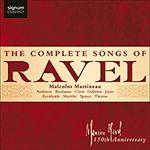‘Ravel's sense of colour and atmosphere is infallible … Finley's mellifluous, malleable baritone is an ideal match for this repertoire, with lines eloquently floated, nuances subtly voiced and character sensitively defined. This is a beguiling programme, beautifully performed’ (Gramophone)
‘It feels inadequate just to describe this enchanting new collection from Gerald Finley and Julius Drake as the best modern recital devoted to the wonderfully varied world of Ravel's songs … Julius Drake's warm-toned playing is, as ever, a perfect foil, all captured in Hyperion's wonderful sound. Riches indeed’ (BBC Music Magazine)
‘These are for the most part works of cool restraint, with passion hidden beneath a jewelled surface, and Finley's wonderfully flexible voice achieves maximum effect with minimal means … Drake's playing is a marvel of delicacy and almost gamelan-like sonorities’ (The Daily Telegraph)
‘It's a beautiful disc that startles in ways you don't always expect … the poetic restraint of Finley's singing and Drake's playing are spellbinding. The settings of Marot and Ronsard are ravishingly done, and the mixture of irony and sadness they bring to Histoires naturelles is exceptional’ (The Guardian)
‘These are songs that deserve to be better known … there are wonderful settings of prose poems by Jules Renard in which the peacock parades, a swan glides across glittering water and a kingfisher perches on a fisherman's rod. Drake relishes Ravel's iridescent piano parts, shifting imperceptibly from picture-painting to psychological comment … [Don Quichotte] magnificently performed by Finley and Drake, these grand mélodies … are a compelling miniature drama in three acts … Finley matches Drake song for song, the naïve knight, the ardent lover and, in 'Chanson épique', a grave and gravelly voice for this most principled of heroes … every track on this fine CD is proof that Ravel … was a composer who rose to a given musical occasion with consummate artistry, conviction and originality’ (International Record Review)
‘Gerald Finley seems to have found his métier here, singing with an enlightened sense of vocal agility and also fidelity to the textual nuances of Ravel's music. This is one of the best Ravel recitals I have heard in a long time (and they don't come often) so if this composer and his songs have any meaning for you at all, grab this disc quick. Julius Drake adds his normally sensitive partnership in music that is truly written for two’ (Audiophile Audition, USA)
‘Gerald Finley dares to tackle and all-Ravel program, and it only takes a few selections to recognize his mastery … the Key here is the Canadian's entirely natural approach, free of affectation or overinterpretation and supported by a voice of consistent beauty, warmth and flexibility … what emerges is not just a great display of vocal artistry, style, diction and characterization’ (Opera News)


 Ravel: The Complete Songs
Ravel: The Complete Songs
